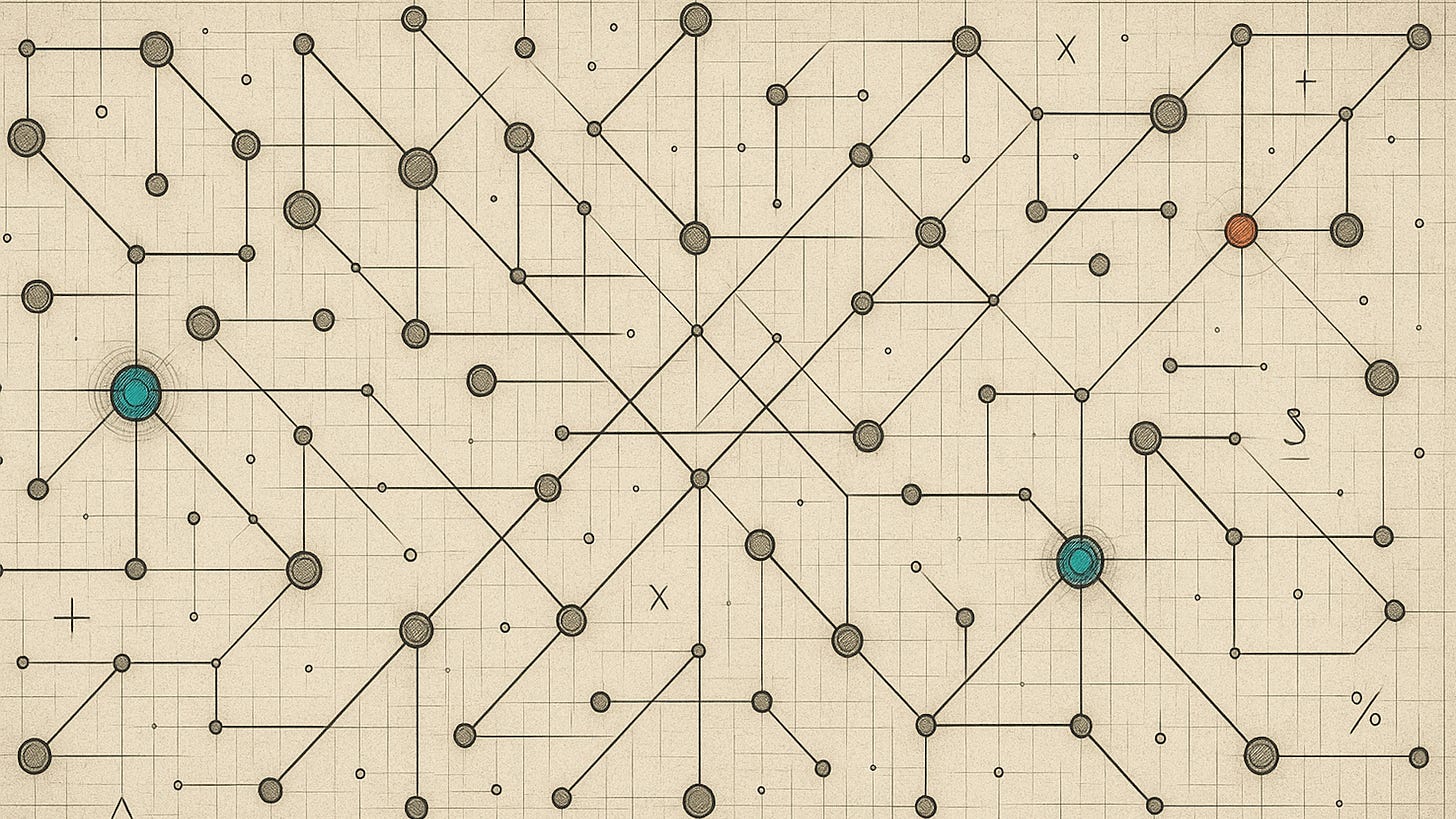The Rise of the Agentic Network Organization (ANO)
What's Next for Teal, DAOs, Holacracy, unFIX and RenDanHeYi? Agentic AI Combined with Networked Organizations. A Killer Combo.
What's Next for Teal, DAOs, Holacracy, unFIX and RenDanHeYi? Agentic AI Combined with Networked Organizations. A Killer Combo.
Welcome to my explorations at the intersection of AI leadership, algorithmic management, and the future of work. In this age of AI, I focus on how networked and decentralized organizations can thrive with agentic AI, gig work models, and new approaches to AI management. If you're curious about the evolution of networked organization structures and the role of gig workers in tomorrow’s economy, you’re in the right place.
ANOs are the next logical step in the evolution of Teal, Holacracy, unFIX, RenDanHeYi, and DAOs.
Note: After writing this post on Agentic Networked Organizations (ANO), several readers kindly pointed out that “ano” already has a rather... anatomical meaning in Spanish and Italian.
This is hilarious, considering I did ask Perplexity if the term had prior uses worldwide. It gave me plenty of meanings and acronyms—but not this one. Maybe it censored itself?
The irony is too rich to ignore, so I’m leaving this post unchanged. I was petrified for ten seconds, and then I just had a good laugh. Just a reminder: don’t trust AI too much. And never take yourself too seriously. However, in future posts, I will refer to NAOs (Networked Agentic Organizations).
Despite valiant attempts to get rid of traditional hierarchies—and yes, I did my best as well—most organizations are still stuck in the Management Age.
For decades, forward-thinking minds experimented with alternatives to rigid management bureaucracy: Teal organizations, Holacracy, fractal organizations, unFIX patterns, RenDanHeYi and most recently, Distributed Autonomous Organizations (DAOs). Each of these models offered compelling promises: more autonomy, better adaptability, less management overhead, and more meaningful work.
But in the age of AI, a new reality is emerging—an organizational paradigm that synthesizes the strengths of the earlier models, fixes their weaknesses, and embraces a future filled with human, robots, and agents. Those older approaches aren't dead. They are valuable stepping stones toward a great convergence of thinking.
Let's discuss the Agentic Network Organization (ANO).
What Is an ANO?
An Agentic Network Organization is an organizational structure emerging in the AI-powered, post-management era. It consists of a fluid network of autonomous agents—both human (employees, contractors, gig workers) and artificial (AI agents, robots)—coordinating purposefully without relying on traditional hierarchy.
ANO also stands for Assistant Nursing Office, Air Navigation Order, Approximate Natural Orbital, and Above Named Officer. None of this is in any way relevant to this article.
Rather than forcing people into rigid roles or control structures, ANOs enable distributed initiative, where each actor—human or machine—can pursue goals, make decisions, and coordinate with others using mutual agreements and shared protocols.
Think of it as the natural evolution of agile and decentralized work, upgraded for a world of AI, platform economies, and digital ecosystems.
ANOs are the next phase in the evolution of Teal, Holacracy, unFIX, RenDanHeYi, DAOs, and every other organizational model enabling a shared purpose with decentralized control.
Why Now?
A convergence of socio-technological forces makes this moment ripe for the rise of ANOs:
🌐 Global Gigification: The number of freelancers, contractors, and part-time workers keeps rising. Traditional employment models no longer fit the way people want to work.
🤖 AI-Powered Agents: Generative AI and autonomous agents are no longer sci-fi. Soon, they can plan, decide, act, and even negotiate. Organizations will integrate them not as tools, but as teammates.
🧩 Composable Tech Stacks: Blockchain, APIs, low-code/no-code platforms, and modular architectures make it easier than ever to build networked workflows across traditional boundaries and silos.
🌍 Decentralized Expectations: From crypto communities to younger generations, people nowadays expect to contribute without having to climb a corporate ladder or report to a boss or supervisor.
📉 Management Obsolescence: There’s widespread dissatisfaction with bloated middle management and slow decision cycles. AI is doing to decentralization what COVID did to remote working.
For inspiration, check out, "Google's Sergey Brin says management is the 'easiest thing to do with AI'"
In this context, ANOs aren’t a futuristic concept—they’re the obvious next step.
How ANOs Include and Transcend Existing Models
🟢 DAOs
ANOs inherit the peer-to-peer logic and distributed governance of DAOs, but without being confined to blockchains or tokenomics. ANOs are compatible with, but not dependent on smart contracts. Implementing an ANO on the blockchain as a DAO is a great idea, but not required. It is perfectly valid for a small group of people to work as an ANO with nothing but verbal agreements. It would be even more promising to let the humans have conversations and leave the DAO implementation to their AI agents.
🟢 Holacracy
ANOs embrace Holacracy’s role-based fluidity and distributed authority, but don’t require everyone to read a constitution or follow rigid meeting formats. ANOs allow autonomy through principles and protocols, and will not let bureaucracy creep back in. Most importantly, because ANOs can emerge bottom-up, they transcend Holacracy's default approach of top-down implementations.
🟢 Teal Organizations
Teal was visionary in promoting wholeness, evolutionary purpose, and self-management, but the movement lacked in offering anyone practical advice for the next steps to take. ANO is also (for the moment) merely an abstract concept, but it comes with the potential to add a sharper focus on practical implementation, AI integration, and networked accountability. With ANOs, Teal can meet Tech.
🟢 Haier’s RenDanHeYi
Haier’s model of thousands of micro-enterprises is a clear ANO precursor. Each unit operates with micro-entrepreneurial freedom and collaboration between those micro-enterprises happens with smart contracts on the blockchain. ANOs throw AI agents into the mix and generalize the fractal logic across digital and hybrid environments, enabling cells of humans and agents to self-coordinate within a larger mesh.
🟢 unFIX
With the unFIX model, I did my best to describe versatile organization design with cards, webpages, and workshop materials. But let's be honest, though many say they've been inspired by the unFIX patterns, the model was never meant to assist with concrete implementations. I left that important task to consultants and managers. In the age of ANOs, we'll see AI agents and protocols do the manager's job.
What Makes ANOs Different
Agent-augmented work: Integration of AI agents as collaborators, not tools
Post-management logic: Coordination via protocols, not middle managers
Scalable modularity: Fractal structures that grow without losing agility
Cross-boundary composition: Employees, freelancers, and machines working in concert
Protocol-first governance: Agreements and workflows, not org charts and policies
Blockchain-agnostic: Compatible with DAOs and tokens, but not reliant on them
This makes ANOs not just an evolution of org design—but a redefinition of what it means to organize.
So What Can You Do With This?
Right now? Nothing.
We still lack standard protocols that allow people to collaborate across traditional boundaries. DAOs, Holacracy, Teal, RenDanHeYi and unFIX were good steps, but they were insufficient. We have work to do.
For now, if you’re an organization designer:
Use the concept of the ANO as a lens to audit your clients’ org structure.
Prototype agent integrations: what workflows can be handled by LLMs or bots?
Help leaders shift from “managing people” to designing collaborative protocols.
If you’re an agile consultant:
Rethink Scrum and SAFe as the transitional scaffolding toward ANOs.
Introduce clients to minimum viable micro-enterprises, not just flatter org charts.
Facilitate agent–human team retros and new forms of decentralized decision-making.
Final Thought: From Organizations to Organisms
Agentic Network Organizations are not created—they emerge.
They are not “designed”—they are grown.
Also interesting and completely irrelevant: In Greek, "ἄνω" (anō) is an adverb meaning "above," "upward," or "heavenward"
ANOs shift the focus from job titles to contributions, from hierarchies to networks, and from middle managers to coordination protocols. They are fully compatible with the tools and challenges of our time—AI, autonomy, and agility.
The question is no longer if we’ll evolve beyond traditional organizations.
The question is, how are we going to do this?
This Is Not a Manifesto But a Call for Harmony
The Revenge of Agile: From Amazon to Patagonia and from Jira Tickets to Judgment Day. The Future of Work Is Agentic AI and Networked Organizations.
p.s. I will soon invite you to collaborate with me on HARMONY, a protocol for human-agent relationship management. The exact thing we'd need to grow an ANO. Watch this space.
The future of work isn’t just hype or doom. It’s about human-robot-agent collaboration—and those who master that will thrive. I’ll be your guide and skeptical optimist in a rapidly changing world. Subscribe to my Substack and get ahead.





Looking forward to see how you develop these ideas further
Despite the admittedly hilarious name in Spanish (which literally translates to an unfortunate anatomical reference), I find this approach valuable and it aligns with many of my own ideas—some of which I've explored in my book "Bionic Organizations." I believe we're heading toward increasingly strong integration between humans and AI agents, fundamentally redefining what we mean by "organization." These entities will likely become more "bionic" and augmented over time. I'm eager to see how this field continues to evolve.